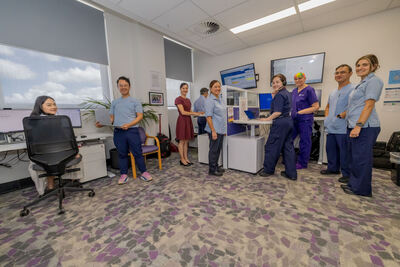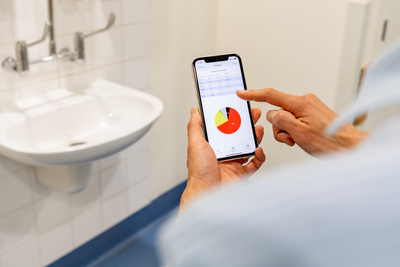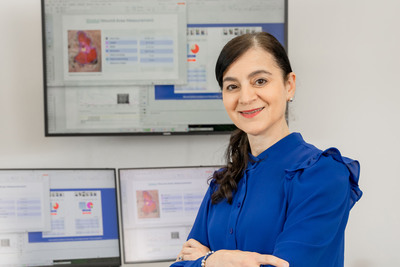Healing without borders: wound care for home and residential aged care

Wound care is one of the most common and resource-intensive clinical challenges in aged care. Whether it’s a pressure injury, diabetes-related foot ulcer or chronic venous leg ulcer, delays in specialist assessment can lead to deterioration, hospital transfer, and a poorer quality of life for residents and clients.1
Professor MICHELLE BARAKAT-JOHNSON — named the winner of the 2025 Health Minister’s Award for Nursing Trailblazers by Minister for Health and Aged Care Mark Butler — along with the team at RPA Virtual Hospital have been able to close this gap through the RPA Virtual Hospital Wound Care Command Centre, a pioneering service that connects clinicians (including aged-care workers) directly with wound care specialists, no matter where they are.
Michelle takes Aged Health on a tour.
The Command Centre is a practical, scalable way to bring expert wound care to the bedside, or the lounge room, quickly, safely and cost-effectively. It gives aged-care teams real-time advice from specialist nurses, supported by digital wound assessment tools and structured clinical pathways, without the wait for an external clinic appointment.
How the Centre helps residential aged care and home-based services
1. Faster specialist input, fewer transfers
One of the most tangible benefits is the speed of specialist triage. For a resident with a deteriorating wound, an on-demand virtual review can quickly determine who needs urgent escalation and who can be safely managed on site. This prevents unnecessary ambulance transfers and ED presentations.
Economic modelling and early evaluations from the Command Centre have already shown reduced downstream hospital use and measurable system cost savings when wounds are managed earlier in the community.2 For older people, this means less disruption and care in the comfort of familiar surroundings.

2. Building local workforce capacity
Virtual reviews are more than decision-making tools; they are learning opportunities. During each consult, specialist nurses can guide care staff and visiting clinicians through wound assessments, dressing choices and pressure-relief strategies.
Research and pilot projects show that this real-time, case-based education improves confidence and skill among aged-care nurses and personal care workers.3 Over time, these skills translate into better prevention, earlier detection and more effective management of wounds — benefits that multiply across every resident or client in their care.
3. Better continuity across settings
For home care clients, multiple providers may be involved, for example community nurses, GPs and allied health professionals.4,5 Without a centralised record, wound progress can be difficult to track.
The Command Centre’s digital platform (Tissue Analytics)6 standardises wound photography and measurements, ensuring consistent monitoring. Any changes can be identified earlier, and care plans adjusted without the patient leaving home. This is particularly valuable for frail older people or those living in remote locations where travel is both challenging and costly.

4. Faster decision-making for allied health and visiting clinicians
Allied health practitioners, including podiatrists, occupational therapists and physiotherapists, often play critical roles in wound prevention and healing. Because the Wound Care Command Centre is housed within the RPA Virtual Hospital, access to RPA and district services is quick and easy, ensuring timely specialist input. Wound care is never done in isolation, so allied health professionals work closely with clinicians to identify and manage related issues such as cellulitis, lymphoedema and diabetes-related foot ulcers. Allied health practitioners play vital roles in wound prevention and healing.
The Command Centre offers a single pathway for these professionals to obtain wound-specific advice during their visits or call in if they have any concerns about a patient they are caring for. This ensures that mobility plans, footwear choices and pressure-redistribution strategies are well aligned with overall wound management goals.
This coordinated approach reduces conflicting recommendations and improves the overall care experience for the client.
**************************************************
Other innovations
The WoundView (COVIU) integrated app study
Alongside the Command Centre, there are other exciting advances in virtual wound care for aged care. Michelle is a co-investigator on a separate project led by Associate Professor Georgie Luscombe and Dr Annie Banbury in partnership with Coviu Global and The University of Sydney.
This study is developing a wound app for residential aged care facilities and external wound care providers. The app, which is built into the Coviu telehealth platform and uses consumer-grade devices such as mobile phones, will enable secure wound imaging, documentation and management within care teams, streamlining how clinicians in different locations collaborate on wound care.
This innovation could make virtual wound consultations even more accessible for facilities and home-visiting clinicians who need quick, reliable tools without complex new systems or the need to download an app or purchase cameras or specialist imaging devices.
**************************************************

1. Ahmajärvi KM, Isoherranen KM, Pessi TJ, Venermo MA. The impact of diagnostic delay on wound healing — a cohort study in a primary care setting. Int Wound J. 2025;22(5):e70141. doi: 10.1111/iwj.70141
2. Barakat-Johnson M, Newton M, Cayley C, Lai M, Dixie L, Alexander N, Pelusi M, Chan J, Cohen A. Digitising wound care: a cost-consequence analysis of the Wound Care Command Centre™ in Australia. BMC Health Serv Res. 2025;25(1):873. doi: 10.1186/s12913-025-12969-2
3. Rayner JA, Mahoney AM, Fetherstonhaugh D, Cowen S. Models of education for care workers in Australian nursing homes: improving the care of older people. Front Public Health. 2025;13:1584889. doi: 10.3389/fpubh.2025.1584889
4. Norman RE, Gibb M, Dyer A, et al. Improved wound management at lower cost: a sensible goal for Australia. Int Wound J. 2016;13(3):303–316. doi: 10.1111/iwj.12484
5. Australian Government, Department of Health. Report from the Wound Management Working Group. Medicare Benefits Schedule Review Taskforce; June 2020. Accessed 14 August, 2025. https://www.health.gov.au/sites/default/files/documents/2020/12/report-from-the-wound-management-working-group_1.pdf
6. Barakat-Johnson M, Jones A, Burger M, et al. Reshaping wound care: evaluation of an artificial intelligence app to improve wound assessment and management amid the COVID-19 pandemic. Int Wound J. 2022;19(5):1081–1094. doi: 10.1111/iwj.13755
What might the eyes tell us about aging and cardiovascular risk?
Researchers have explored how the eyes might be able to predict a person's risk of developing...
The missing link in aged care: how untreated hearing loss impacts mental health and mobility
A principal audiologist explains the link between untreated hearing loss and mental health and...
New initiative sets sights on dementia, palliative and complex care solutions
A provider specialising in dementia, palliative and complex care for older Australians has...



